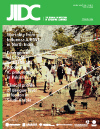Emergence of CTX-M Group 1-ESBL producing Klebsiella pneumonia from a tertiary care centre in Karachi, Pakistan
DOI:
https://doi.org/10.3855/jidc.674Keywords:
Gram negative, extended spectrum beta lactamases, multidrug resistance, hospital acquired infections, non-clonal isolates, carbapenam resistance.Abstract
Background: Extended-spectrum beta-lactamase (ESBL)-producing Klebsiella pneumoniae have been reported previously from Pakistan but the genotypic characteristics of these enzymes is not known. Hence the aim of the study was first to characterise the genotypic content of these beta-lactamases and secondly to assess the clonal relationship of these isolates.
Methodology: We analysed 65 non-duplicate ESBL positive, K. pneumoniae isolates prospectively collected based on phenotype as detected using the two-disc method. Isolates were collected from different sources: blood cultures (46.15%; n = 30); tracheal aspirates (24.6%; n = 16); urine (10.7%; n = 7); wound swabs, pus and tissue (18.4%; n = 12). ESBL production was confirmed by the ESBL E-test method and the presence of the blaCTX-M encoding genes was confirmed by polymerase chain reaction. The clonal relationship of clinical isolates was studied by Pulsed Field Gel Electrophoresis.
Results: The results showed that 93.84% (n = 61) isolates of K. pneumoniae were positive for the blaCTX-M-1 group. One isolate showed PCR signals for blaCTX-M-25 group. None of our isolates were positive for CTX-M groups 2, 8 and 9. The majority of blaCTX-M positive isolates were genetically unrelated and no epidemic clones were identified. Conclusion: This study reports the emergence of CTX-M groups 1 and 25 producing isolates of K. pneumoniae with genetic diversity in Karachi, Pakistan.
Downloads
Published
How to Cite
Issue
Section
License
Authors who publish with this journal agree to the following terms:
- Authors retain copyright and grant the journal right of first publication with the work simultaneously licensed under a Creative Commons Attribution License that allows others to share the work with an acknowledgement of the work's authorship and initial publication in this journal.
- Authors are able to enter into separate, additional contractual arrangements for the non-exclusive distribution of the journal's published version of the work (e.g., post it to an institutional repository or publish it in a book), with an acknowledgement of its initial publication in this journal.
- Authors are permitted and encouraged to post their work online (e.g., in institutional repositories or on their website) prior to and during the submission process, as it can lead to productive exchanges, as well as earlier and greater citation of published work (See The Effect of Open Access).








